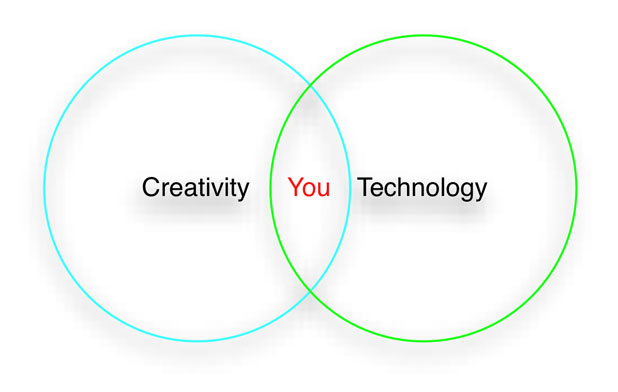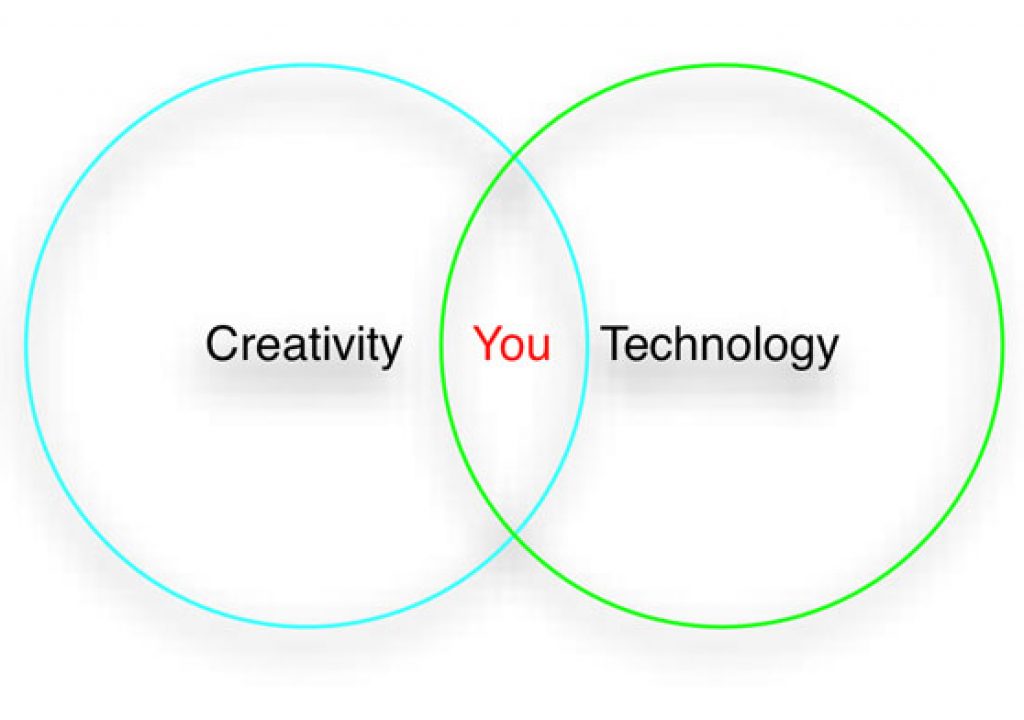
Technology is always advancing, and we’re at the point in this industry where we’ll always have new toys on the near horizon. My question is: how much do these toys matter when it’s the people who use them who provide all the creativity?
On Wednesday I’ll be speaking at Creatasphere’s Entertainment Technology Expo at the Burbank Marriott as part of a ProVideo Coalition panel on the future of technology. Honestly, I’m not so concerned about our technological future: things will always get better, faster and easier over time. My concern is how we, as humans, will relate to technology. The last few years have seen a shift in focus from the people to the tools, and that’s a dangerous path to follow.
More often than not the camera is booked on a job before I am. This puzzles me, because if the camera shows up for work and I don’t nothing is going to happen. If I show up, however, any number of cameras can also show up and everything will be fine. The camera only records pictures, but cinematographers make them. That is a key difference that is not spoken of enough.
Production has always exercised a certain amount of control over how cinematographers shoot things. In days past the DP had a certain amount of say over which film stocks he or she chose, and unless the project at hand was a low budget feature and the producers got a better deal from Fuji than from Kodak, what the DP wanted the DP got. Some studios dictated film stocks (In underrstand that Disney’s contracts stipulate Kodak stocks, and in some cases specific Kodak stocks) but generally it was unthinkable to tell a DP exactly which stocks they would use for what. Cinematography is a complicated craft and most producers were smart enough to hire a DP and give them a certain amount of freedom to do their jobs.
There’d always be budget battles, as there are today. Here’s the lighting budget, make it work; here’s the camera budget, make it work; etc. I was once told by the DP of the TV series “Knots Landing” that production gave him a Cooke 5-1 zoom for the series plus a 35mm prime in case the zoom broke, and that was it. The crucial bit was that there was a DP in place who could make the tools work for the project. Becoming one of those trusted DPs was a long and tricky process.
A few years ago a revolutionary camera came along that put high resolution imagery into the hands of people who traditionally couldn’t afford it. This camera forced a number of staid camera companies to sit up, pay attention and rethink their product lines, and that has definitely been a good thing. The camera’s marketing, however, was so brilliantly done that the creative focus shifted from the cinematographer to the camera. The choice of cinematographer was still important, but the camera was equally if not more important.
The camera became the tool that would put filmmakers on the map. They lost sight that talented filmmakers nearly always succeed, and it’s not because they used a certain camera. It’s because they honed and developed their talent. This company has sold thousands of cameras, and yet we don’t have thousands of additional blockbuster movies every year.
Subsequent cameras have changed the landscape further by offering fairly good imagery for lower cost, which produced a cascading effect: first the focus shifted from the cinematographer to the camera, and then if shifted from the camera to the cost of the camera. The result is that the camera is often chosen independently of the cinematographer, with occasionally hilarious or disastrous results.
A while back a Southern California-based production company contacted me about shooting a national spot. “We’re thinking of shooting on either an Arri Alexa, a RED ONE, a Sony F3 or a Canon 5D,” said the person on the phone. “You know those are very different cameras,” I said. “They offer very different strengths and weaknesses. Can you tell me a bit more about what you’re trying to achieve so I can help you with the choice?”
“Oh, we’re probably going with the RED,” said the person on the phone. “The director hasn’t decided yet so he’s keeping his options open.”
My unspoken question: why was the director making this decision? I’ve been working in the camera department for 24 years, and shooting for 19. I know more about these cameras and their characteristics than is healthy, and if the director had a short conversation with me I could offer him or her some solid insights as to what camera was best for their project and budget. Instead they were going to make the decision on their based on criteria that probably had very little to do with whether it was the best camera for the job. It might have been, but whereas I would know that for certain they’d only be guessing, at best.
In the end they told me they loved my website but I lost the job because they could get a better deal on gear elsewhere. I guess that’s understandable in some weird way, because I’m not in the business of getting people discounts on gear; I’m in business to provide them the quality of work shown on my website, reliably and consistently. Those images can be made with all sorts of gear, but they can’t be made without me.
Having spent some time in the LA system I can state truthfully that, while there are an amazing number of crew people there, it’s very hard to find the ones that are exceptional at their jobs. Everyone says they are, but not everyone is. For this reason many producers seem more comfortable making as many decisions on their own about as many things as possible, and will often repeat a strategy or technique endlessly once it works for them successfully. More and more decisions are removed from the DP’s domain because gear always acts the same, and humans are the wild card. Gear is trustworthy, but–until tried and tested–people are not.
I sympathize with this quandary. I also like to point out that you can put as much equipment as you want on a sound stage but until the people show it’s not going to do much. The camera will not automatically choose the best compositions for the story, the lights won’t magically fall into place, the grip gear will not rise and cast all the necessary shadows. People with a minimum of gear can do great things, but gear without a minimum of people can do nothing.
As cinematographers we should be selling ourselves on our unique vision and abilities, but instead we often find ourselves selling gear. “Yes, I can use that camera,” “Yes, I own that piece of gear,” “Yes, I can give you a better deal than a rental house,” etc. The problem with this approach is that it works as long as there’s no one cheaper around… and there’s always someone cheaper. Somehow the focus must be shifted from the technology back to the people who use the technology, because that’s where all the creativity is.
My suggestion to producers and directors in this regard is to use the same approach that I use with my own crew:
(1) Hire good people who can do their jobs better than you can do their jobs
(2) Tell them what you want
(3) Tell them the parameters (time, budget, etc.)
(4) Let them use their creativity and years of experience to solve the problem in their own way
(5) Repeat
There are numerous situations where I’ve been called to shoot a project, discovered the camera has already been booked, and then tried to back the producer out of that decision–not because of some sort of power play, but because there’s a better way to do it that may save some money. Don’t book a RED ONE for a green screen or white limbo shoot if you need to save money and you don’t need 4K resolution; instead get a Sony EX3 and a KiPro deck instead and no one but your budget will be the wiser. Don’t book a Canon 5D to shoot screen shots because there’s no worse camera to do that with because of its moire issues. If you don’t have the time to gel windows then spend the money on an Arri Alexa and skip the gel, along with the time spent waiting for the gels to be perfected. These are the technical decisions that I can make to save a production time and money.
And those are the least important decisions I will make, because the most important decisions are not technical but creative. Cinematographers make the images, not cameras.
I’m excited about new technology, and I strive to always be on the cutting edge. I want to learn about technologies at a deep level, not so I can build a camera but so I can understand how it will respond in various situations and be able to pick the best tool for the job. But it’s not about the camera, it’s about the people in front of and behind the camera. Technical details are easy. It’s the creating that’s hard, and no two people do it the same way. That’s what makes this business so exciting, and it’s how great projects are realized.
I’ve never heard of a painter pining for a new brush that will enable them able to paint like Van Gogh. If you want a Van Gogh painting then you need to get Van Gogh. The brushes are incidental.
Cameras are brushes. They are tools. It’s the craftsmen who use the tools who make a difference. I’m all for getting excited about new tools, but lets not forget where the real creativity comes from. And let’s be sure to remind those who hire us that we are there for them, as unique individuals, in a way that will benefit them greatly if they allow us to participate both technically and creatively. Choose the artist first, and together you can choose the best brushes for the job.
The PVC Panel will held on Wednesday, November 2nd, from 1:30-2:45 in the Main Theater.
Art Adams is a DP who makes pretty pictures regardless of the technology. His web site is at www.artadamsdp.com.

